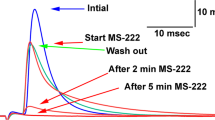Abstract
This study examined the effect of prolonged inactivity, associated with aestivation, on neuromuscular transmission in the green-striped burrowing frog, Cyclorana alboguttata. We compared the structure and function of the neuromuscular junctions on the iliofibularis muscle from active C. alboguttata and from C. alboguttata that had been aestivating for 6 months. Despite the prolonged period of immobility, there was no significant difference in the shape of the terminals (primary, secondary or tertiary branches) or the length of primary terminal branches between aestivators and non-aestivators. Furthermore, there was no significant difference in the membrane potentials of muscle fibres or in miniature end plate potential (EPP) frequency and amplitude. However, there was a significant decrease in evoked transmitter release characterised by a 56% decrease in mean EPP amplitude, and a 29% increase in the failure rate of nerve terminal action potentials to evoke transmitter release. The impact of this suite of neuromuscular characteristics on the locomotor performance of emergent frogs is discussed.



Similar content being viewed by others
Abbreviations
- EPPs:
-
Evoked end plate potentials
- MEPPs:
-
Miniature end plate potentials
- NMJs:
-
Neuromuscular junctions
- RMP:
-
Resting membrane potential
References
Bennett M, Lavidis N (1991) Probabilistic secretion of quanta from the release sites of nerve terminals in amphibian muscle modulated by seasonal changes. Neurosci Lett 134:79–82
DelCastillo J, Katz B (1954) Quantal components of the end plate potential. J Physiol 124:560–573
Eldridge L, Liebhold M, Steinbach J (1981) Alterations in cat skeletal neuromuscular junctions following prolonged inactivity. J Physiol 313:529–545
Flanigan J, Withers P, Fuery C, Guppy M (1993) Metabolic depression and Na+/K- gradients in the aestivating Australian goldfields frog Neobatrachus wilsmorei. J Comp Physiol B 163:587–593
Hainaut K, Duchateau J (1992) Neuromuscular stimulation and voluntary exercise. Sports Med 14:100–113
Hudson N, Franklin C (2002a) Effect of aestivation on muscle characteristics and locomotor performance in the green-striped burrowing frog, Cyclorana alboguttata. J Comp Physiol B 172:177–182
Hudson N, Franklin C (2002b) Maintaining muscle mass during extended disuse: aestivating frogs as a model species. J Exp Biol 205:2297–2303
Hudson N, Franklin C (2003) Preservation of three-dimensional capillary structure in frog muscle during aestivation. J Anat 202:471–474
Hudson N, Bennett M, Franklin C (2004) Effect of aestivation on long bone mechanical properties in the green-striped burrowing frog, Cyclorana alboguttata. J Exp Biol 207:475–482
Kargo W, Rome L (2002) Functional morphology of proximal hindlimb muscles in the frog Rana pipiens. J Exp Biol 205:1987–2004
Lavidis NA (1995a) The effect of opiates on the terminal nerve impulse and quantal secretion from visualized amphibian nerve terminals. Br J Pharm 115(3):441–450
Lavidis NA (1995b) The effect of opiates on the secretion of transmitter from amphibian motor nerve terminals. Eur J Pharm 276(1–2):71–76
Mills R, Bray F, Hubbard J (1978) Effects of inactivity on membrane potentials in rat muscle. Brain Res 150:607–610
Pawson P, Grinnell A (1989) Seasonal changes in the normal variability in release properties of motor nerve terminals in Rana pipiens. Brain Res 495:182–188
Robinson J (1976) Estimates of parameters for a model of transmitter release at synapses. Biometrics 32(1):61–68
Snider W, Harris G (1979) A physiological correlate of disuse-induced sprouting at the neuromuscular junction. Nature 281:69–71
Vyskocil F (1976) Miniature end plate potentials and sensitivity to acetylcholine in the fast and slow limb muscles of hibernating golden hamsters. Pflugers Arch Eur J Physiol 361:165–167
Wernig A, Pecot-Dechavassine M, Stover H (1980) Sprouting and regression of the nerve at the frog neuromuscular junction in normal conditions and after prolonged paralysis with curare. J Neurocytol 9:277–303
Wernig A, Dorlochter M, Palazis P (1996) Differential sensitivity to Mg2+ - and tubocurarine-block of frog neuromuscular junctions in summer and winter. Neurosci Lett 207:41–44
Withers P (1993) Metabolic depression during aestivation in the Australian frogs, Neobatrachus and Cyclorana. Aust J Zool 41:467–473
Zemkova H, Teisinger J, Almon R, Vejsada R, Hnik P, Vyskocil F (1990) Immobilisation atrophy and membrane properties in rat skeletal muscle fibres. Pflugers Arch 416(1–2):126–129
Acknowledgements
This work was supported by an Australian Research Council Large Grant to C.E.F. and a University of Queensland, Research and Development Grant to C.E.F. and N.L. N.J.H. wishes to acknowledge the Northcote Trust from which he received a generous postgraduate scholarship. The SV2 monoclonal antibody developed by Dr K.M. Buckley was obtained from the Developmental Studies Hybridoma Bank developed under the auspices of the NICHD and maintained by the University of Iowa, Department of Biological Sciences, Iowa City, IA 52242, USA. We declare that the experiments complied with the “Principles of animal care” publication No. 86–23, revised 1985, of the National Institute of Health, and also with current Australian laws.
Author information
Authors and Affiliations
Corresponding author
Rights and permissions
About this article
Cite this article
Hudson, N.J., Lavidis, N.A., Choy, P.T. et al. Effect of prolonged inactivity on skeletal motor nerve terminals during aestivation in the burrowing frog, Cyclorana alboguttata. J Comp Physiol A 191, 373–379 (2005). https://doi.org/10.1007/s00359-004-0593-5
Received:
Revised:
Accepted:
Published:
Issue Date:
DOI: https://doi.org/10.1007/s00359-004-0593-5




